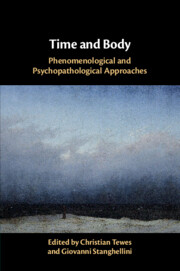Book contents
- Time and Body
- Endorsements for Time and Body
- Time and Body
- Copyright page
- Dedication
- Additional material
- Contents
- Figures
- Contributors
- 1 Introduction – Time and Body
- 2 Time, the Body, and the Other in Phenomenology and Psychopathology
- Part I Body and Time: General Aspects
- 3 The Body – Another
- 3.1 Commentary on “The Body – Another: Phenomenological and Psychoanalytic Perspectives”
- 4 The Heart of Darkness of the Living Body
- 4.1 Commentary on “The Heart of Darkness of the Living Body”
- 5 Microphenomenology of Chronicity in Psychosomatic Diseases
- 5.1 Commentary on “Microphenomenology of Chronicity in Psychosomatic Diseases: Diabetes, Anorexia, and Schizophrenia”
- 6 Time and Embodiment in the Process of Psychotherapy: A Dynamical Systems Perspective
- 6.1 Commentary on “Time and Embodiment in the Process of Psychotherapy: A Dynamical Systems Perspective”The Musicality of Human Interaction
- Part II Grief and Anxiety
- Part III Borderline Personality and Eating Disorders
- Part IV Depression, Schizophrenia, and Dementia
- Index
- References
5 - Microphenomenology of Chronicity in Psychosomatic Diseases
Diabetes, Anorexia, and Schizophrenia
from Part I - Body and Time: General Aspects
Published online by Cambridge University Press: 30 October 2020
- Time and Body
- Endorsements for Time and Body
- Time and Body
- Copyright page
- Dedication
- Additional material
- Contents
- Figures
- Contributors
- 1 Introduction – Time and Body
- 2 Time, the Body, and the Other in Phenomenology and Psychopathology
- Part I Body and Time: General Aspects
- 3 The Body – Another
- 3.1 Commentary on “The Body – Another: Phenomenological and Psychoanalytic Perspectives”
- 4 The Heart of Darkness of the Living Body
- 4.1 Commentary on “The Heart of Darkness of the Living Body”
- 5 Microphenomenology of Chronicity in Psychosomatic Diseases
- 5.1 Commentary on “Microphenomenology of Chronicity in Psychosomatic Diseases: Diabetes, Anorexia, and Schizophrenia”
- 6 Time and Embodiment in the Process of Psychotherapy: A Dynamical Systems Perspective
- 6.1 Commentary on “Time and Embodiment in the Process of Psychotherapy: A Dynamical Systems Perspective”The Musicality of Human Interaction
- Part II Grief and Anxiety
- Part III Borderline Personality and Eating Disorders
- Part IV Depression, Schizophrenia, and Dementia
- Index
- References
Summary
In this contribution I will examine a few aspects of the peculiar temporality of chronic time considered in the light of its pathological dimensions. I will do so by using three different methods and resources and interweaving them: the clinical literature on the topic, conceptual philosophical frameworks, and first-person microphenomenological explicitation interviews. Since chronicity as a scientific theme is quite a virginal issue, such a complex multifaceted approach is required. My inquiry is based on Adochronic, a Research Program I lead at the Université de Rouen Normandie, which investigates three chronic diseases in teenagers: diabetes, anorexia, and schizophrenia. The broad hypothesis of this contribution is to show how chronicity may be less a sheer property of these diseases (among others) than a global transverse pathology with social and civilizational consequences, with these diseases being then in turn local properties of the global pathology.
Keywords
- Type
- Chapter
- Information
- Time and BodyPhenomenological and Psychopathological Approaches, pp. 82 - 97Publisher: Cambridge University PressPrint publication year: 2020



